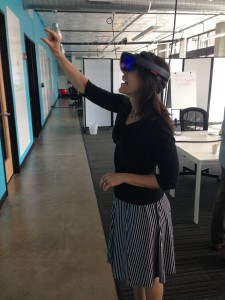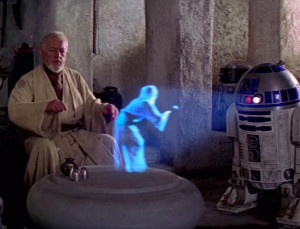FOUR Hololens headsets. That’s how many devices are in-house at Oregon Story Board, the nonprofit story-and-technology accelerator in Portland, Oregon’s mobile-dev-rich Pearl district. This is a coup for Portland-area tech innovators. Microsoft might have released as little at two thousand units globally, though Microsoft isn’t publicly releasing numbers. Even if that number is a great as ten thousand, we’re still talking about a technology that’s very new. It may not to be in the hands of consumers for another three-five years.
You’ve definitely seen a hologram. The most famous is Princess Leia beaming out of R2D2: “Help me, Obi-Wan Kenobi. You’re my only hope.”
Hololens is an elegant, lightweight headset that allows viewers to see holograms, that is, 3D images, and hear “spatialized” sound. By 3D, I mean the holograms are pinned to a particular location, and you can walk around them and see them from all sides. Unlike virtual reality (VR), holograms and sounds are overlaid over the real world. Microsoft is getting behind the term “mixed reality” to capture the way holograms and real life mesh into one. The other term you’ll hear to describe it is “augmented reality.”
Personally, I like MR (AR) better than VR. I like being able to talk with other people around me as I’m playing with holograms. The social dimensions of MR make it alluring. What’s “reality” after all? Isn’t it wherever your friends are?
I HAD A BLAST playing with Hololens. Here’s what I did:
- I selected and placed a still, animated hologram that looked liked Saturn. I walked around it and looked from all angles.
- I placed on a table a live action ballerina pirouetting to the Nutcracker, and walked around her.
- I explored the galaxy using Galaxy Explorer, an interactive map. Anything I selected was animated, and a voice explained facts. The sun was a little buggy and wouldn’t deselect.
- I talked with someone using Skype. Hololens wrote a Skype plugin, which basically gives people the ability to draw on the screen display. This could be useful if you were reviewing documents. The pen function is still pretty primitive, like a kindergartner holding a crayon in her fist.

You open the menu by blooming your hand open, and select by pinching thumb and forefinger. Image: Cora Wigen.
What uses do people have for holograms popping into and out of the ordinary world?
Plenty, if you ask me.
Yesterday, OSB Director Shelley Midthun invited me and ten other Portland designers, business people, and story experts into OSB to pilot their one-day Hololens Training. Our goal? To play with the gear and then figure out applications pertinent to our organizations.
Led by Thomas Wester and Ben Fischler, this training gave us a clear technical overview of how Hololens works, what kinds of programming and assets it requires, and how images and other objects are stitched together. We then reviewed four test cases of potential use, including automotive (Volvo), interior design and collaboration (Skype), building construction and architecture (Trimble) and education (Case Western Reserver University). Then we brainstormed and formed into into small, project-specific groups and prototyped a use case. We came up with very cool stuff! Not sure if I’m allowed to share them, but suffice to say that I’m convinced this technology will be as important a shift in how we do business as mobile has been.
And that’s saying a lot, because I think mobile is the most relevant shift in computing since the invention of the personal computer!
I could envision several educational uses. Medical and other kinds of technical training are obvious wins, but even the humanities would benefit from MR. Imagine an art history class where you’re not watching 2D slides in a dark room, but walking around a sculpture, even an enormous kinetic Calder. Or a literature class where the spatialized sound recreates the Dylan Thomas reading in a cathedral. In short, education can become more experiential and embodied as we move forward into technologic creations that shrink the distance between us and the historical objects we study. Museums and cultural heritage organizations could do a tremendous amount with this technology, delivering a walk around the Roman Colossesum, for example.
Microsoft Hololens is funding experiments in commercial and public service uses for Hololens. Oregon Story Board won, along with its partners Intel and Clackamas Community College, a $100K grant to develop an application for teaching transmission gearing in CCC’s automotive department. Led by Thomas and Ben, they are building Hololens app that will let students play with a 3D model of a transmission. Because these digital objects are scalable, even tiny valves can be made large for further examination. (The other four winners of the Microsoft Research Grant were U.C. Berkeley, Carnegie Mellon, Dartmouth and Virginia Tech. Way to punch above your weight class, CCC!)
Microsoft is offers a hologram design academy for developers to start making cool stuff. I believe it’s now possible to develop for play with holograms using all kinds of devices, including Kinect. Hololens devices cost about $2000 or $3000 (I’ve seen documentation for both figures). Developers can load emulators for free.
If you’re in the Portland area (or you’re not, but you want to visit PDX and touch the hologram future), consider registering for Oregon Storyboard’s one-day Hololens training, which will be available starting next week (June 13) for $995.





